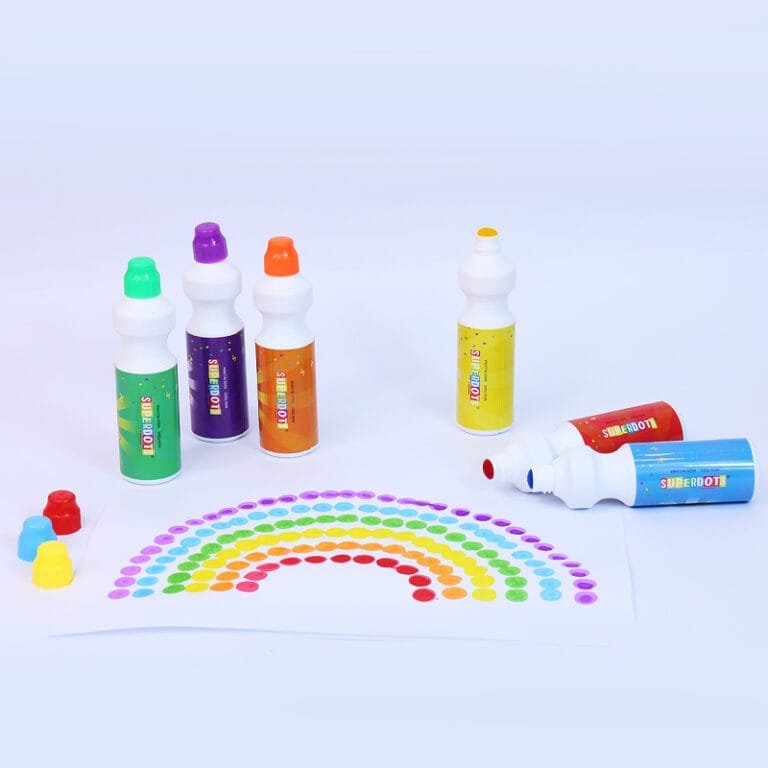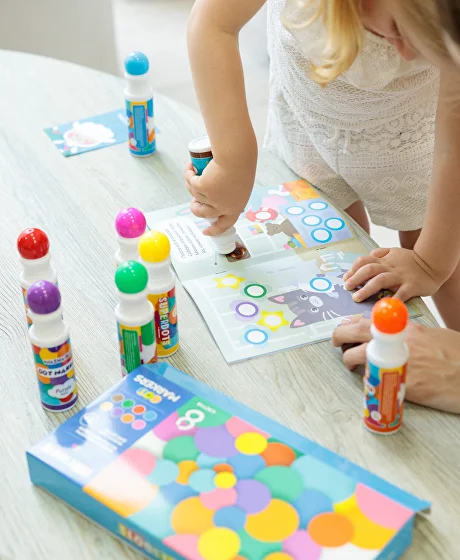Dot markers (also known as dot stampers, Do-A-Dot markers, bingo daubers, etc.) are highly popular tools in children’s art activities. Due to their fun and easy-to-use nature, they’ve become a favorite among parents, teachers, and young artists alike. These simple yet effective tools play an important role in children’s education and creativity development. Today, let’s dive into the background, features, benefits, and applications of dot markers.
What Are Dot Markers?
Dot markers are art tools designed specifically for young children. They have a large, round tip that makes it easy to stamp bright, vibrant dots onto paper. In addition to being used as stampers, dot markers can also be used like regular markers to draw thick lines, allowing children to freely express themselves through art. These markers are perfect for toddlers and preschoolers, thanks to their simple design and ease of use.
Dot markers are not just for coloring or drawing; they’re also great for teaching kids the alphabet, numbers, and basic shapes. As children grow, dot markers can help improve fine motor skills and hand-eye coordination, all while encouraging creativity and exploration.
The History of Dot Markers
The origin of dot markers dates back to the 1970s. Initially, these tools started out as simple stampers, used to help children make colorful dots on paper. Over time, the concept evolved into the more versatile, user-friendly dot markers we know today.
By the 1990s, dot markers began to gain popularity in the market, becoming a go-to choice for parents and educators alike. Brands like Do-A-Dot Art and Chalkola helped promote the safety and educational benefits of dot markers, making them a staple in classrooms and homes. As early childhood education and creative arts gained importance, dot markers became a vital tool in both learning and play.
In recent years, dot markers have seen continuous innovation. New colors, designs, and ink formulations have been introduced, making them even more adaptable for different age groups and creative needs. Today, dot markers are widely used across the globe, not only for artistic expression but also for educational purposes.
Functions and Uses of Dot Markers
Dot markers are incredibly versatile and can be used in a variety of creative and educational activities. Here are some of the main functions and ways to use them:
- As an Art Tool: The round tips of dot markers are perfect for creating bold dots and patterns. Kids can use them to make all sorts of designs, from simple shapes to intricate pictures. They can also be used to draw thick lines, helping children practice their drawing skills.
- As an Educational Tool: Dot markers are not just for art; they are widely used in educational settings to teach letters, numbers, shapes, and more. For example, parents and teachers can use dot markers to help children learn to count, trace letters, or identify shapes through fun, hands-on activities.
- Fun Activities: Dot markers are ideal for dot-to-dot games, color matching exercises, and pattern creation. These activities stimulate creativity while also promoting cognitive development.
The Benefits of Dot Markers
Dot markers come with several key advantages, making them a favorite for both kids and parents:
- Safe and Non-toxic: Most dot markers use non-toxic, water-based ink, ensuring they’re safe for children. Parents can rest easy knowing their little ones can use them without harm.
- Easy to Clean: Thanks to their water-based ink, dot markers are easy to clean up. If kids get marker on their hands or clothes, it’s easy to wash off, making them parent-friendly.
- Helps Develop Fine Motor Skills: The act of stamping dots and drawing lines helps children strengthen the muscles in their hands and fingers, which is important for later skills like writing and using scissors.
- Fosters Creativity: Dot markers encourage free-form creativity. Kids can experiment with colors, create their own patterns, and explore the world of art without limitations.
Where and How Dot Markers Are Used
Dot markers are popular in a variety of settings, both at home and in educational environments. Here are a few examples of how dot markers are used:
- At Home: Dot markers are perfect for parent-child bonding activities. Whether it’s creating fun art projects or helping children practice their ABCs, dot markers offer endless possibilities for learning and play at home.
- In Schools: In early childhood education, dot markers are often used in classrooms to engage children in hands-on learning. Teachers use them for activities that teach math, language, shapes, and more, while also encouraging creativity.
- In Art Therapy: Dot markers are also used in art therapy, helping children express their emotions through creative projects. By drawing and stamping, children can develop a better understanding of their feelings and boost self-expression.
Conclusion
Dot markers are not only a fun and creative tool but also a valuable educational resource. They help children develop important skills like fine motor coordination, creativity, and early literacy—all while providing hours of entertainment. Whether at home, in school, or in therapy, dot markers have become a beloved tool in fostering artistic expression and learning.



